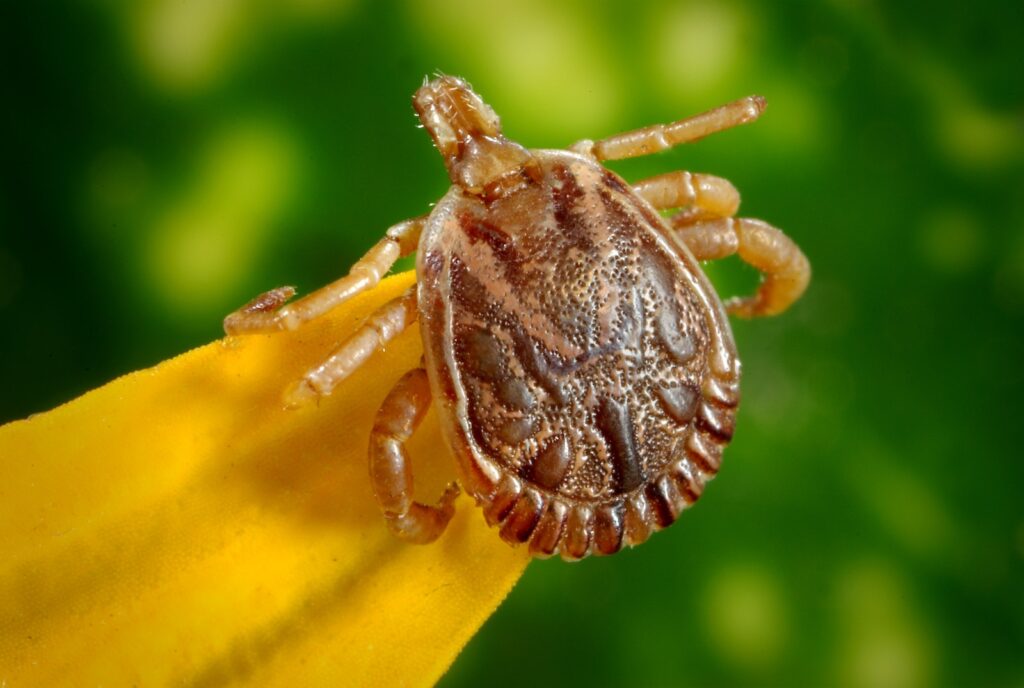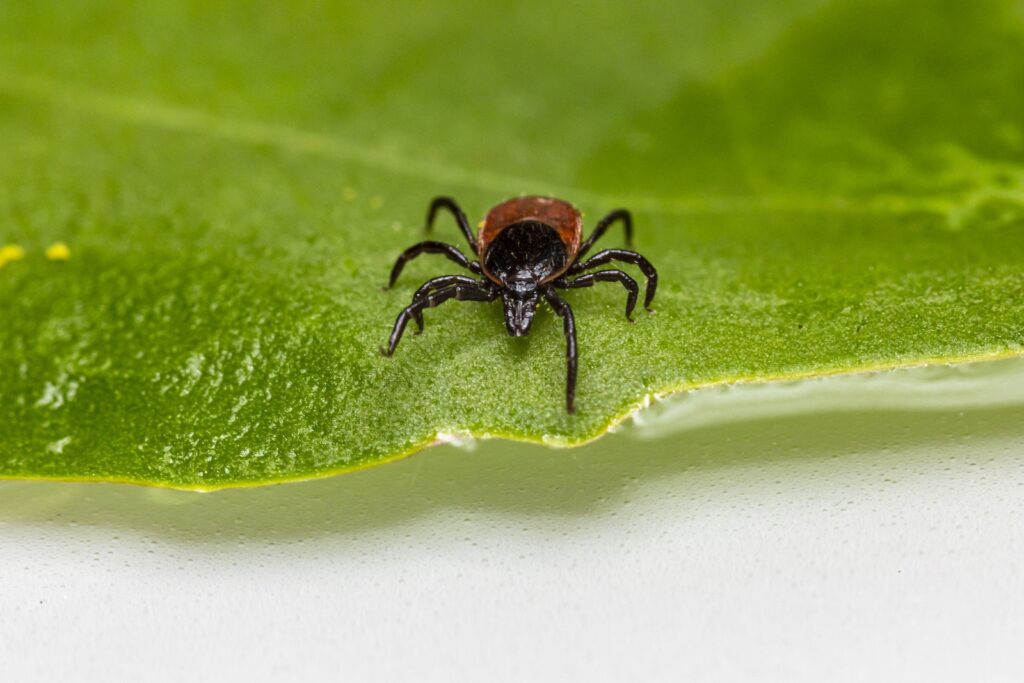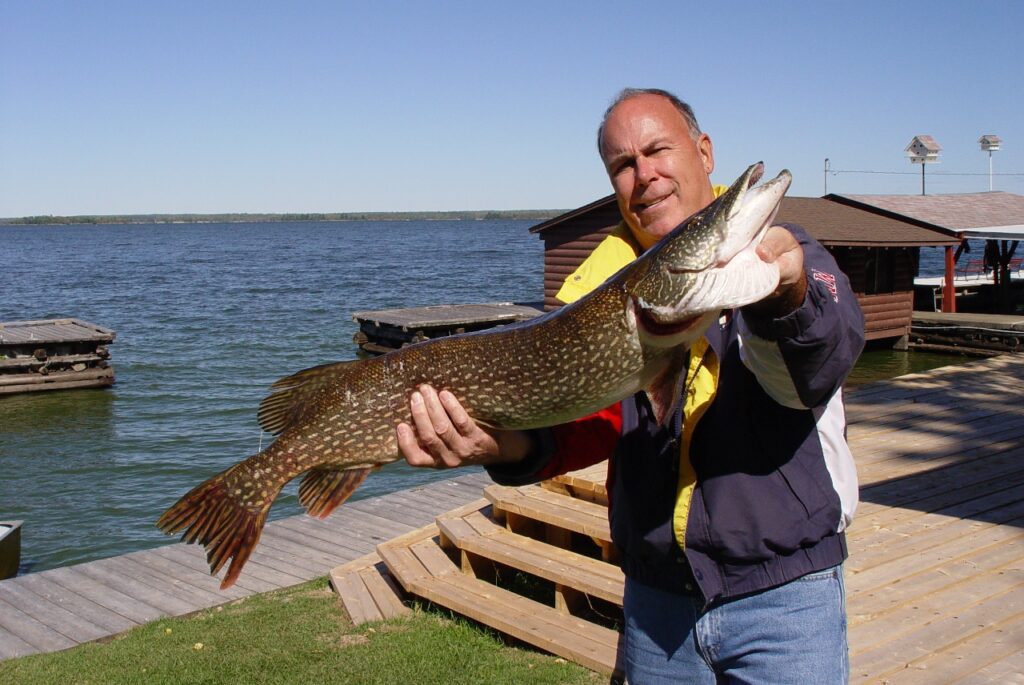I remember my first encounter with ticks. I was about 9 years old and on one of the many family vacations to Bagley Minnesota. Undressing and getting ready for bed one night, I noticed a small brown “bug” slowly making its way up my leg.
Close Encounters of the Tick Kind
I picked the unwelcome intruder from my leg and set it on the nightstand, observing its plodding attempt at movement. Being a young boy, I attempted to smash it by pounding it with my tiny fist; it simply kept crawling. I tried to squeeze it to a pulp between my thumb and forefinger… Again, it defied my attempts to kill it.
Taking the small, brown insect to my father for analysis (he was a storehouse of knowledge about such things), I was informed – rather nonchalantly – that the “bug” was in fact a tick.
Upon hearing this, my mother screamed and immediately insisted upon searching every square inch of both me and my sister to insure there were no more ticks around, claiming that: “Ticks carry all sorts of bad germs and if they bite you, you can get very sick… maybe even die!”
She was obviously a bit more concerned than my father, who apparently knew that ticks were to be expected up north and did not find them to be so intimidating. “Tick checks” have since become almost a nightly ritual ever since, on every trip I make to the Northwoods.
Hosts of Ticks
Actually, ectoparasites (meaning external, with the emphasis on parasite), ticks obtain a blood meal from a host. The unsuspecting host can be a reptile, bird or mammal (of which we are obviously one). All ticks are bloodsucking parasites, and blood is an absolutely necessary requirement for both survival and reproduction of the species.
Tick is simply the common name for this pest that is part of the arachnid class (spiders are arachnids). This nasty and very large and diverse group also includes the well-known house dust mites.
My mom was right-on when she proclaimed that ticks carry germs. They don’t really cause the disease, but they do convey/transmit it from one host to another! And therein lies a major part of the problem. Ticks must bite you to get the blood they need. It’s not so much the bite itself but what is in the tick’s bodily fluids that does the damage.
Since I am directing most of my articles towards those of you that head north to Wisconsin and Minnesota, I’ll concentrate my efforts on the ticks that you may encounter in those states.
Tick Types
Minnesota has more than a dozen types of ticks, but only three are likely to be encountered. They are 1) the American Dog Tick (also called the Wood Tick), 2) the Blacklegged Tick (formerly Deer Tick) and 3) the Brown Dog Tick. From what I have read, Wisconsin apparently has only the Wood Tick and the Deer tick.
Since dogs are the only hosts for the Brown Dog Tick, we probably need be concerned only by the other two varieties. Unless of course you own a dog, in which case you would obviously be concerned if your dog spends time outdoors and in a wooded area. There are, however, some important things to note about both the Wood Tick and the Blacklegged (Deer) Tick.
Both kinds mentioned here are hard-bodied ticks, meaning that they have an exterior that is fingernail-like in nature. In general, the males are a slightly different color and a bit smaller than the females, although the females can become much bigger (engorged) after a large blood meal.
In the case of Deer Ticks, they are roughly the size of a poppy seed or flake of ground pepper, while the Wood Ticks are typically much larger (2 mm to perhaps as much as 6 mm in length). During their life cycle and development from egg to mature adult, ticks pass through several stages. These include a larval form that has only three pairs of legs.
Removal of Ticks
This is followed by a nymph form with four pairs of legs, just like the adult. In order to feed, ticks bite through the skin and then insert the narrow, head-like front part of the body (with the mouthparts) into the wound. They then anchor their head firmly into the skin by means of barbs on their jaws.
Because of this, ticks can be quite difficult to remove; It is not a good idea to attempt to forcibly pull a feeding tick off the skin, since this often results in the mouthparts being torn away and left embedded in the skin. If this happens, the embedded parts left in the wound are likely to become infected and cause further complications. (More on removal later)
Both the Wood Tick and the Blacklegged (Deer) Tick require at least two years to complete their life cycles. They are generally most active from late spring to early fall — the times when humans are vacationing in areas that have woods, tall grass, and shrubby vegetation.
Here the ticks spend a good deal of time just waiting for an unsuspecting host to pass by. Like mosquitoes, ticks are quite sensitive to carbon dioxide as well as motion. When the vegetation in which ticks reside is disturbed, the tick lets go of the plant and attaches itself to the passerby so that it can hitch a ride and enjoy a free meal!
Diseases Carried by Ticks
After the tick has finished feeding it will drop off, but the damage may have already been done. Several diseases can be transmitted to humans and domestic animals through tick bites, tick bodily fluids or tick excrement. Wood Ticks can be carriers of several infections of humans including relapsing fever, tularemia, some forms of encephalitis, Texas cattle fever, and Rocky Mountain spotted fever. Fortunately, these diseases are uncommon in Minnesota and Wisconsin.
Lyme disease on the other hand, is a different matter. First discovered and reported near Old Lyme, Connecticut in 1975, the disease is caused by a spirochete (a type of bacteria) called Borrelia burgdorferi and carried by the Blacklegged Tick.
Tick Bite Signs & Symptoms
Ticks are most prevalent in east-central Minnesota and west and southwest Wisconsin. Although it takes a deer tick 24-48 hours of feeding before they can transmit Lyme disease, the results of a bite can be very serious. After being bitten by this type of tick, the first symptom to occur is usually a bull’s-eye shaped rash around the bite. The rash expands to form a large bright red ring with a clear center which often is hot to the touch.
Other symptoms at the onset may include flu-like symptoms like fatigue, chills, a low-grade fever, headache, muscle pain, sore throat and nausea or vomiting. Several days to several months later, symptoms resembling arthritis can develop; serious heart problems may also occur. If you suspect that you may have been bitten, see a doctor as soon as possible. Although diagnosis of Lyme disease within the first week or two is sometimes difficult, the sooner one can begin treatment, the better.
One very important fact is worth noting here: Minnesota and Wisconsin are not the only states where the Blacklegged Tick and Lyme disease are found. At least 45 states have reported cases of the disease. In 1996 alone, 17,00 cases were reported in those states and the problem appears to be growing.
Removing Ticks
If a tick is found to be attached to your skin, what is the best way to remove it? Opinions seem to differ a bit on the answer to this question. Nail polish remover or burning matches aren’t effective ways at all.
Some websites will tell you to put things like Vaseline or light oil on the tick, claiming that it will cause the tick to suffocate and drop off, while other sites claim that this does absolutely no good. My guess is that perhaps it wouldn’t hurt to at least try it, and not wait long for the “remedy” to take effect. But the best advice is to make certain to have a small pair of tweezers or a Tick Remover Kit available.
Remember that prompt removal of ticks decreases the chances of getting Lyme disease. Grab the little guy as close as possible to the skin where it is attached and slowly, but gently pull the tick straight out, making certain that the head portion comes with the rest of the tick and also making certain that the tick is not crushed in the process; the bodily fluids may contain the bacteria that causes the disease and you don’t want to get that stuff into the bite!
Save the tick in a small jar with alcohol for identification through local or state health department offices. Make a note of dates, times, places, etc. Wood ticks, by the way, have not been shown to be carriers of Lyme disease!
So, what can you do to prevent being bitten by this tiny, disease-carrying mite? There are a number of things:
- When hiking in a wooded area, be sure to stay in the middle of the trail and avoid walking through areas of tall grass
- Keep as much of your skin covered as possible; wear long sleeve shirts and long pants with the pant legs tucked into your socks.
- Repellents with the active ingredient DEET applied to clothing and skin will help keep ticks off of those areas
- If possible, wear light-colored clothing so that it is easier to see a tick if they are on the clothing
- Make certain to conduct tick checks at regular intervals!
The old saying “An ounce of prevention is worth a pound of cure” goes a long way toward feeling better and safer when you and your family are in the great outdoors. And just being aware and knowledgeable will go a long way toward helping to give you greater piece of mind.
As always, I hope to see you On the Lake!
rk









